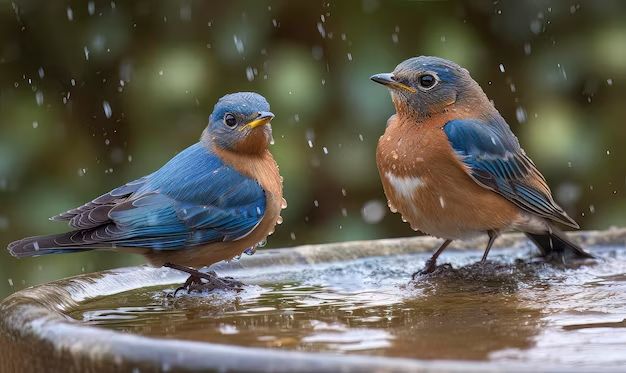Bluebirds have long been associated with cheerfulness, happiness, and good fortune. Their bright plumage and melodious songs symbolize joy and optimism. Many cultures consider bluebirds to be lucky and view their presence as a positive omen. But where does this belief come from and is there any truth to it? Let’s explore the history and folklore around bluebirds as harbingers of good luck.
Folklore and Mythology
Bluebirds have been revered in folklore and mythology for centuries. In many Native American tribes, spotting a bluebird was considered a sign of plentiful crops or successful hunting. Bluebirds were viewed as spiritual messengers that carried prayers back to the Creator.
In European folklore, bluebirds were associated with springtime and the return of warmer weather. Their seasonal migration patterns linked them to renewal and rebirth. Christians maintained that the bluebird’s vibrant blue plumage represented heaven and seeing one on Easter was especially fortuitous.
Symbolism and Meaning
So why are bluebirds infused with such positive symbolism across cultures? A few key traits help explain their auspicious reputation:
| Bluebird Trait | Positive Association |
|---|---|
| Bright blue plumage | Cheerfulness, joy |
| Melodious song | Happiness, optimism |
| Return in springtime | Renewal, rebirth |
The bluebird’s radiant blue feathers and pleasant warbling song stir feelings of cheer and hope. Their seasonal return represents the lifecycle continuing as winter transforms back into spring.
According to bird expert Jennifer Polanz, “Seeing a bluebird is a splash of color and song that lightens your mood. It’s a small moment of natural beauty.” This uplifting effect helps explain why bluebirds are considered lucky sightings.
Real-World Significance
Beyond symbolic meaning, a bluebird sighting can hold significance in more practical terms:
– Bluebirds indicate a healthy habitat. They thrive in open woods and meadows with low-growing grasses and perches for hunting insects. If bluebirds are present, it means their preferred environment exists.
– More bluebirds may arrive. They are often spotted in migratory flocks, so spotting one bluebird means more may be on their way.
– Pest control. Bluebirds are voracious predators of harmful insects like grasshoppers, crickets, and cutworms. More bluebirds means fewer pests.
So while their spiritual symbolism may be debatable, bluebirds do provide real ecological benefits. Their presence intrinsically improves an area, which could also be deemed an omen of good fortune.
Omens Across Cultures
Bluebirds are primarily considered good omens in Western cultures. But perspectives differ across the world:
| Culture | View of Bluebirds |
|---|---|
| Native American tribes | Positive omen of bounty |
| European folklore | Sign of springtime renewal |
| Christianity | Represent heaven/good fortune |
| Chinese culture | Omen of love and marital happiness |
| Irish folklore | Associated with fairies and the supernatural |
While there are some variations, bluebirds are largely considered auspicious across cultures. Their universality as symbols of optimism and cheer appears deeply rooted.
Examples in Literature
The positive symbolism of bluebirds has extended into literature over the centuries. Here are some notable examples:
– In Shakespeare’s The Winter’s Tale, the line “the bluebird of happiness” appears, linking bluebirds to joy.
– Poet Lucy Larcom’s poem “Bluebird” celebrates their beauty and song, calling them “glad prophets of the spring.”
– Maurice Maeterlinck’s play The Blue Bird centers around two children seeking the magical Blue Bird of Happiness.
– Tennessee Williams titled his famous play The Glass Menagerie after the collection of glass animal figurines, including bluebirds, owned by main character Laura.
These works showcase how bluebirds and their uplifting aura have inspired artists and writers over time. Even fiction reflects their cultural symbolism as beacons of cheer.
Bluebirds in Artwork
In addition to literature, bluebirds have been featured prominently in artwork and decorative arts:
| Type | Examples |
|---|---|
| Porcelain | Wedgwood bluebird jewelry, Limoges boxes |
| Textiles | Sampler motifs, quilting patterns |
| Paintings | Bluebird of Happiness by Charles Wysocki, Bluebird Morning by Karla Gerard |
| Stained glass | Tiffany bluebird lamps and windows |
Dating back to the Romantic era, bluebirds were a recurring subject for painters and artisans. Their graceful forms and symbolism made them popular decorative motifs. Today, images of bluebirds remain prevalent on household items, jewelry, apparel, and more.
Bluebirds in Weddings
Due to their longstanding connection to joy and optimism, bluebirds play a special role in weddings:
| Significance | Examples |
|---|---|
| Symbol of marital happiness | Bluebird cake toppers, invitations |
| “Something blue” | Bluebird bouquet charms, jewelry |
| Decor motifs | Centerpieces, lighting, signage |
Bluebirds provide the “something blue” that brides have long incorporated for good luck. Their happy symbolism sets the tone for an auspicious union filled with joy and prosperity. Spotting a bluebird on one’s wedding day is considered a very fortuitous omen.
Conclusion
While they may not actually possess any mystical powers, bluebirds do carry cultural significance as symbols of happiness, prosperity, and new beginnings. Their bright plumage and cheerful song lights up the landscapes they inhabit, so their presence intrinsically brings positivity. So while they may not tangibly “bestow” good luck, bluebirds can certainly lift our spirits and remind us to appreciate nature’s simple blessings. In that sense, they truly are good omens of cheer that may just brighten your day.


